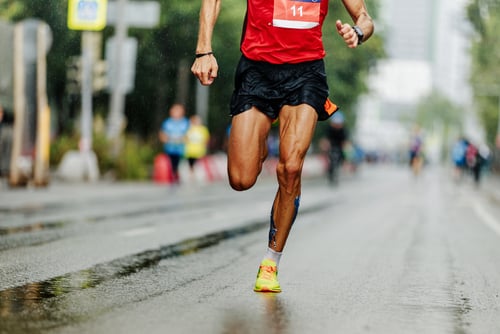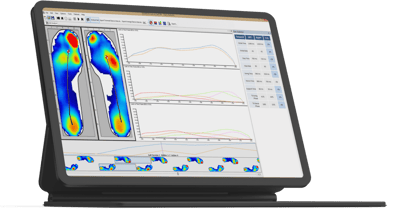
Gather Accurate In-Shoe Plantar Pressure Measurement Readings
Understanding Human Gait Through Data To Increase Safety and Performance
Our feet carry us through the day, each day. They bear the weight of our bodies and the additional weight from walking or running, gravity and holding heavy loads. They put up with lifting children, hiking uphill and long hours just standing around. Their ability to keep working, maintain balance, and stave off injury each and every day is nothing short of a miracle until they can’t do it anymore.
If you’re a clinician or athletic trainer familiar with the mechanics of feet, of course, you already know this. Moreover, you likely already know the importance of a good in-shoe plantar pressure measurement system. The ability to accurately measure pressure across the sole of the foot can help you assess the gait impairment, diagnose problems and develop treatment plans – not to mention better shoe technologies such as gait motion insoles.
We’re here with a brief tutorial on what in-shoe plantar pressure measurement is, how to get accurate readings and what type of technology you should consider for your facility.
The Human Gait: History and Difficulties
As we begin to age, overuse our feet or use improper footwear, they begin to complain. Changes in routine can also lead to greater injuries, as shifting exercise routines in the pandemic showed us.
Until they are hurt, most people never think twice about the motions of walking or running. We learn instinctively how to do these things when we’re tiny, so as adults, they are second nature. Thanks to millions of years of evolution, we don’t even have to focus before picking up one foot and putting it back down, which propels us forward as naturally as breathing.
That is not to say the mechanics of the foot itself are uncomplicated. Each footstep is a careful choreography of raising the foot, swinging it forward, placing it back on the ground, then putting weight on it. That weight increases as you pick up the opposite foot and do the same thing. Rinse, repeat.
While many people have an ordinary gait and experience no foot problems, others do not. Some people are more athletically inclined than others; some have great natural balance, while others may lack it, it can also deteriorate with age. People manifest different levels of neurological readiness, while others are simply in pain.
It is difficult to pinpoint the reasons for any of this without hard data. And while podiatrists have been treating feet for hundreds of years, it is only in recent decades that their solutions have been based on science. Many in-shoe plantar pressure measurement systems available on the market today do a poor job gathering natural gait data. Let’s turn our attention to what they are supposed to do and why it doesn’t always work.

Why Is In-Shoe Plantar Pressure Measurement Important?
Understanding the biomechanics of gait is critical to solving whatever issues make an individual’s foot/feet hurt or underperform. This is as true for professional athletes as it is for high schoolers in youth leagues and elderly people who want to maintain consistent exercise habits. The problem with this is that gait is a highly complicated mechanical process. It involves literally hundreds of data points per stride.
That’s where in-shoe plantar pressure measurement can help. Such systems measure the pressure on the sole – or plantar side – of the foot to give a highly accurate, real-time, three-dimensional picture of what it is experiencing at every stride point. They can also reproduce what is happening while the foot is standing still.
Knowing such tiny details is key to changing maladaptive gait aspects that negatively influence movement, athletic prowess, or simply daily life. Analysing each zone of the foot separately – with an eye toward the synergy of the whole – is foundational to helping patients heal from injury, train appropriately and arm themselves with proper footwear.
How Does In-Shoe Plantar Pressure Measurement Work?
The next question most people ask is, how does it work? While the software and technologies are complicated, the in-shoe plantar pressure measurement process is relatively straightforward. First, the clinician inserts a sensor insole into the shoe, which will wirelessly transmit data points to a computer, tablet or smartphone.
Next, software on the device will turn those hundreds or thousands of data points per second into a complete map of the foot’s movement in real-time. This is complete with multiple metrics, such as:
- Mean pressure
- Peak load/pressure
- Center of pressure (COP) location
- Shift speed of COP
The in-shoe plantar pressure measurement software helps to model the foot standing still, heel striking, during the swing phase and at every other point of walking, running, jumping, etc. This allows physicians and trainers to develop a baseline profile for the patient’s or athlete’s foot and use that pressure map to make the best clinical decisions.
Ideally, one would use a thin, flexible, comfortable sensor array inside the shoe to minimise disruption to the natural stride. In reality, however, that’s not always the case.
The Right Systems for Obtaining Accurate In-Shoe Plantar Pressure Data
Many systems on the market today are inflexible, uncomfortable, expensive or need constant recalibration. They make the acquisition and analysis of data difficult, endangering the physician’s ability to make the correct diagnosis and treatment plans. That won’t work, so you need an in-shoe plantar pressure measurement system from an industry-leading company.
XSENSOR foot mapping technology reduces or eliminates the problems normally associated with plantar pressure mapping. We offer the highest level of accuracy and detail with various options, such as intelligent insole sensors and stance pad sensors.


